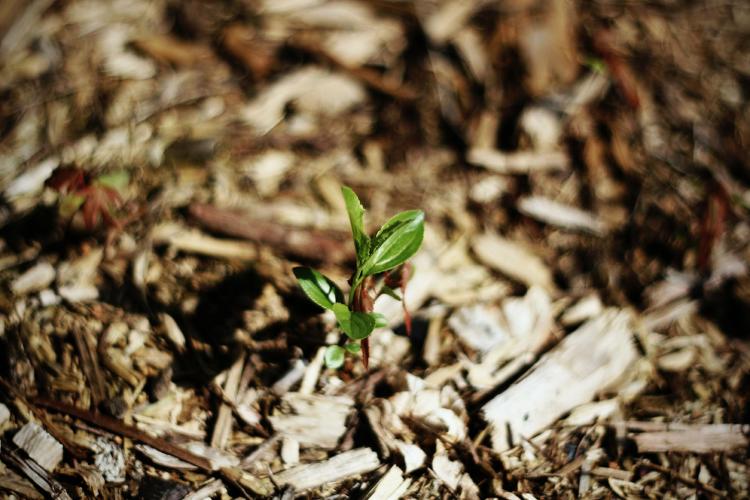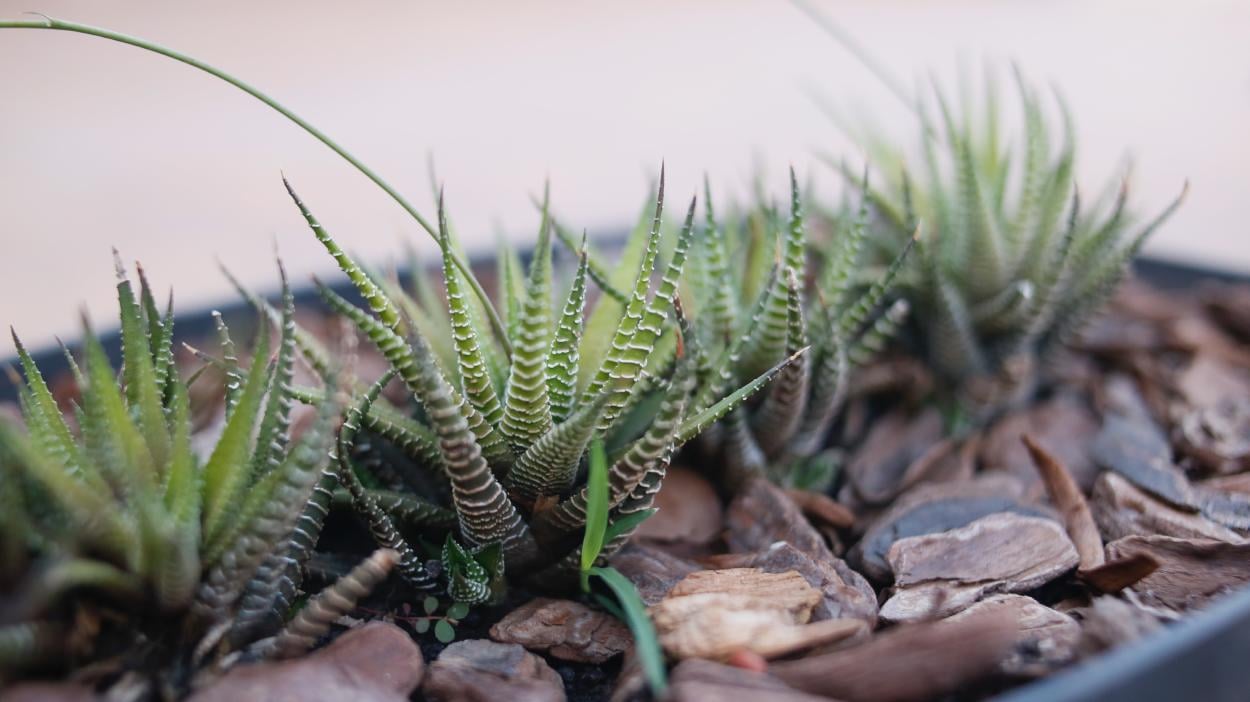Most of the time we get to know what Mulch is because of its aesthetic features. And it is true that a coating of mulch may make your garden seem sharp. But beauty is merely a bonus. Mulch's advantages extend far beyond its appearance. In this article, learn about mulch and How to garden with mulch!!
Before getting into all of the benefits that come with How to garden with mulch, let's define what mulch is: a layer of material used as a covering over exposed soil. There are numerous materials available for this purpose, but the only ones you should ever consider using in your garden are those made from natural and biodegradable materials. This is only a suggestion from another sustainable warrior like you. If you are not sure about how many mulch bags you should get for your garden, you can check our article
Wood chips, pine bark, leaves, straw, and grass clippings are all examples of How to garden with mulch since they decompose and bring numerous additional benefits to your soil. All of those are natural materials that do not biodegrade or take decades to decompose. Some of you might be wondering what difference does it make if a mulch material is natural and biodegradable. Well, let's first start with a list of all the benefits of mulch.

Mulch is known for being great for any garden, and it will also make any other garden beautiful. It can dramatically enhance the appearance of your lawn and the plants in your garden beds.
Some Other Benefits of How to Garden with Mulch are:
-
Retains Moisture:
Mulch acts as an insulator against evaporation caused by heat and wind. It retains moisture in the soil, allowing you to drastically reduce the frequency and duration of watering. This stimulates older plants to become more drought-tolerant, but it can also make or break new shrubs and trees.
-
Moderates Soil Temperature:
Many of a plant's feeder roots grow in the first few inches beneath the soil surface. When those roots are not subjected to excessive heat or freezing conditions, they remain healthier. A layer of mulch works as a temperature barrier. In addition, heat from the sun can burn exposed soil, forming a crust that prevents water from penetrating the surface. A blanket of snow can give protection as temperatures drop; however, without snow or a mulch layer, an overnight frost or sustained freezing temperatures can kill or damage feeding roots.
-
Protects the Soil Surface:
If soil crusts over and becomes impervious to water, rain and irrigation will run over the surface, bringing topsoil particles and any chemicals or excess fertilizer with it. Crusted soil is also more prone to wind erosion. You may already be aware that soil compaction can cause long-term issues, which is why you should never walk in your garden or landscape beds. Did you also know that heavy rain or hail can have the same compacting effect? Mulch may shield your soil from all of these harmful pollutants.
-
Suppresses Weed Germination and Growth:
Weeds are unavoidable in the garden, but if you utilize mulch correctly, you may drastically reduce their numbers. With a layer of mulch covering your garden soil, weed seeds won't get the light they need to grow, and mulch can prevent seeds that drift in on the wind from reaching the soil and taking root. Weeds that do germinate will be buried by mulch and are less likely to become established. Mulch is one of the single best things you can do to manage weeds in your garden for all of these reasons. I can usually tell when the mulch layer on the GardenFarm needs to be replenished since it's where the weeds are growing.
-
Controls Soil-Born Diseases:
Many plant diseases can be found in the soil. While some diseases infect plants through the root system, the majority must come into touch with the foliage. Splashing water from rain or irrigation can bring soil-borne diseases up from the earth and onto the lower leaves of your plants. Disease infections that come into contact with the plant's foliage can infect it. Mulch functions as a shield to inhibit disease migration through water, lowering the risk of plant illnesses dramatically.
-
Organic nutrients:
A healthy soil should include roughly 30% organic matter. Native soils, such as clay and sand, are frequently deficient in organic matter. Mulch, like compost, is an excellent source of organic material for improving soil health. Natural mulch material degrades over time. This is a big benefit of mulch that non-natural or non-biodegradable mulches do not provide. As a result, I only recommend natural, biodegradable mulch products.
-
Reduces Landfill Waste:
Many mulches are made from items that would otherwise wind up in a landfill. Wood, leaves, and pine bark are all too frequently discarded. Consider them to be nature's gifts to gardeners. We are significantly reducing landfill waste by employing wood mulch products. In reality, 60% of all material disposed of in a landfill should be composted, utilized as mulch, or repurposed.
How do I know if my mulch is good?
Decomposition provides some of the most significant benefits of mulch. So it stands to reason that a good mulch is one that will degrade over time while not introducing any detrimental materials into the process. This material should also be sourced in a sustainable manner if you want to learn how to garden with mulch. The ideal mulch is determined by the location and the type of mulch you are using.
It is a fact that the smaller the materials are, the faster they will decompose. This rule applies also to composting. You want a substance that would decompose quickly in your garden, particularly if you are growing some veggies. Shredded leaves and finely ground bark will protect your soil during the growing season, but by the end of the season, when it's time to amend with compost, the majority of those small mulch bits will have broken down into a soil-like mixture. As a result, you should supplement the layer with compost without having to remove the mulch layer.
Many shipping pallets are coated with methyl bromide, a deadly insecticide, to kill insects that may have made their way into the United States from other nations. Pallets that have reached the end of their useful life are ground up, colored to appear attractive, and sold as mulch. You don't want methyl bromide near your plants, especially if they're edible. So, while they may appear attractive, avoid colored mulches.
Another thing to avoid is using cypress mulch products. These are popular because cypress lasts a long time. However, most of the time it is not collected in a sustainable manner. These items are typically sourced from wild cypress forests. Too often, these trees are felled intentionally for use as mulch, despite the fact that trees take decades to mature. Despite the fact that cypress forests in Louisiana and Florida are in serious decline, they are nonetheless exploited for mulch. There are simply so many more environmentally friendly solutions to pick from.
Consider ordering in bulk if you need more than 27 bags of mulch for your yard. It will cost less, and many bulk mulch vendors will transport it to your place. Another advantage of purchasing in bulk is that the material is typically supplied locally, resulting in a lesser carbon footprint.
When it comes to ground-up building materials, colored mulch products are known to contain demolition waste and treated wood. The vegetable-based dyes are used to make the wood from all of those different sources look similar, but there's no way of knowing what chemicals might be lurking in those beautifully-colored wood chips.
- You may be interested at this post: How Many Mulch Bags do you Have to Consider in a Yard?
What Types of Mulch can I Find?
There are different types of mulch that serve different purposes. Let's look at the advantages and disadvantages of the most widely available types.
-
Leaves:
Shredded leaves are an excellent material to work with. They look great, and they hit the decomposing spot. But they also protect the soil all season and become a soil-like consistency just in time for the fall compost amendment.
-
Wood Mulch:
There are numerous possibilities for wood mulch, some of which were already mentioned. How do you choose between chip items, finely ground alternatives, hardwood, pine, and others? Aside from the items and risks mentioned, what you should utilize is a matter of personal preference. Hay and straw are readily available from home improvement stores, garden centers, and farm suppliers.
Both solutions are simple to implement and look good in the landscape. These two materials have significant variances. Straw is derived from grain crops and is just the stalk of the crop. As a result, seed heads are rarely found in straw. It's easier to deal with yet takes longer to decompose than hay. Hay comes from grass crops such as fescue and bluegrass, hence it will most likely contain seed heads. The biggest issue is that the grass crop is usually sprayed with a persistent herbicide, which will take years to evaporate and can destroy your soil in the process.
-
Pine Straw:
This is a popular mulch in the southeastern United States. The pine straw is slow to decompose, and while it is acidic, it will have little effect on the pH of your soil. This substance is harder to spread, but once it is in place, it holds together well and can even be sculpted.
-
Grass Clippings:
This is a great option to learn how to garden with mulch if you are lazy and don't want to pick up all those clippings after mowing.
-
Shredded Paper:
Because it is biodegradable and abundant, you can use it as mulch. Nowadays, most inks are soy-based and so do not pose a health risk. Shredded paper is not particularly attractive and will clump together once wet, but it could be a fantastic solution for mulching plants in a hoop house or a low tunnel.
-
Living Mulch:
What exactly is living mulch? It could be a ground-hugging plant such as creeping thyme or phlox, or it could be a cover crop such as vetch or clover. Living mulch, particularly cover crops, provides numerous advantages to soil health. These choices preserve the soil surface while also outcompeting and shading out weeds.
How much mulch do you need and how should it be used once you've chosen the accurate type for your garden? Keep in mind that you shouldn't spread mulch too thinly, or it won't be enough to deliver the benefits you hope. A thin covering will not be as efficient at suppressing weeds or protecting the soil from heat, erosion, and other factors. However, if you lay the mulch too heavily, you will create other issues. Mulch that is overly dense can actually prevent water from reaching the soil. It can also suffocate your plants.
Now that you know everything you need to know about mulch, are you going to pick up the best one for your garden?
- You may be interested at: Discover How a Garden Window Can Enhance your House and More

